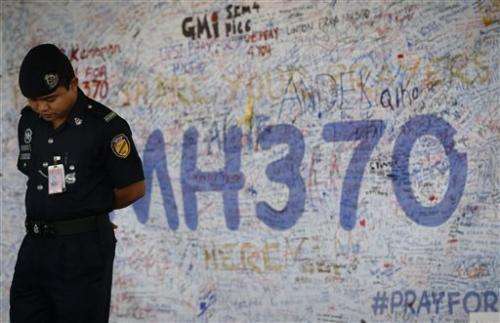Thai radar adds possible clue to trace jet's route

New radar data from Thailand gave Malaysian investigators more potential clues Wednesday for how to retrace the course of the missing Malaysian airliner, while a massive multinational search unfolded in an area the size of Australia.
Search crews from 26 countries including Thailand are looking for the plane that vanished early March 8 with 239 people aboard en route from Kuala Lumpur to Beijing. Frustration is growing among relatives of those on the plane at the lack of progress in the search.
Investigators have identified two giant arcs of territory spanning the possible positions of Malaysia Airlines Flight 370 about 7½ hours after take-off, based on its last faint signal to a satellite. Cmdr. William Marks, a spokesman for the U.S. Navy's 7th Fleet, said finding the plane was like trying to locate a few people somewhere between New York and California.
Aircraft from Australia, the U.S. and New Zealand on Wednesday scoured a search area stretching across 305,000 square kilometers (117,000 square miles) of the Indian Ocean, about 2,600 kilometers (1,600 miles) southwest of Perth, on Australia's west coast.
Merchant ships were also asked to look for any trace of the plane. Nothing has been found, the Australian Maritime Safety Authority said.
Early in the search, Malaysian officials said they suspected the plane backtracked toward the Strait of Malacca, off western Malaysia. But it took a week for them to confirm Malaysian military radar data suggesting that route.
Thai military officials said Tuesday their own radar showed an unidentified plane, possibly Flight 370, flying toward the strait minutes after the Malaysian jet's transponder signal was lost. Air force spokesman Air Vice Marshal Montol Suchookorn said the Thai military doesn't know whether the plane it detected was Flight 370.
Thailand's failure to quickly share that information may not substantially change what Malaysian officials now know, but it raises questions about the degree to which some countries are sharing their defense data.
The jet took off from Kuala Lumpur at 12:40 a.m. March 8 and its transponder, which allows air traffic controllers to identify and track it, ceased communicating at 1:20 a.m.

Montol said that at 1:28 a.m., Thai military radar "was able to detect a signal, which was not a normal signal, of a plane flying in the direction opposite from the MH370 plane," back toward Kuala Lumpur. The plane later turned right, toward Butterworth, a Malaysian city along the Strait of Malacca. The radar signal was infrequent and did not include data such as the flight number.
When asked why it took so long to release the information, Montol said it didn't raise any alarms at the time because the signal was not of something heading toward Thailand. He said the plane never entered Thai airspace.
Later, when Malaysia requested data, Thai authorities had experts take a new look at the data and then forward the details, Montol said.
Investigators now will be checking previous Malaysian military radar data against the Thai data to see if they can confirm locations for the plane and possibly a direction it was heading in order to narrow the search area, aviation safety experts said.
The two sets of data have to be "overlayed" to confirm that the hits, or targets, are recording the same plane or that it is indeed a plane and not a flock of birds or even a rainstorm. To do that, investigators need to determine that both radars were looking at the same place in the sky at exactly the same time down to the second.
Because the plane's transponder had been turned off the hits don't contain identification, location or altitude. Both radars were recording what's known as a primary return—essentially a radar signal bouncing of an object in the sky and returning.
"All you see is a little dot moving across the screen," said Rory Kay, a U.S. airline training captain and former Air Line Pilots Association safety committee chairman.
Malaysia has said the loss of communications and change in the aircraft's course are consistent with a deliberate diversion of the plane, whether it was the pilots or others aboard who were responsible. Police are considering the possibility of hijacking, sabotage, terrorism or issues related to the mental health of the pilots or anyone else on board, but have yet to say what they have uncovered.

Malaysia Airlines CEO Ahmad Jauhari Yahya said some sort of problem aboard the plane was not out of the question, although he noted the plane was intact enough to send a signal to a satellite for several hours. Observers have noted that some sort of distress signal would have been likely in the event of a cockpit fire.
As further confirmation that someone was guiding the plane after it disappeared from civilian radar, airline pilots and aviation safety experts said an onboard computer called the flight management system would have to be deliberately programmed in order to follow the route taken by the plane as described by Malaysian authorities.
"If you are going to fly the airplane to a waypoint that is not a straight ... route to Beijing, and you were going to command the flight management computer and the autopilot system, you really have to know how to fly the airplane," said John Gadzinski, a U.S. Boeing 737 captain.
Investigators have asked security agencies in countries with passengers on board to check their backgrounds, but no suspicious findings have been announced.
China said it found no links to terrorism among the 154 Chinese citizens on board, apparently ruling out possible involvement of Uighur Muslim militants who have been blamed for terror attacks within China.
© 2014 The Associated Press. All rights reserved.


















